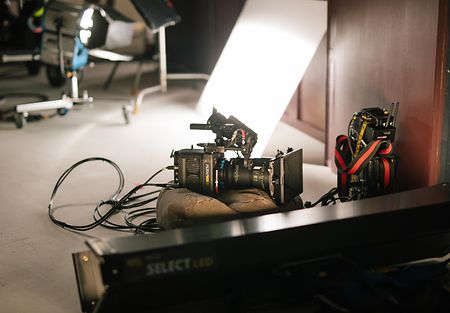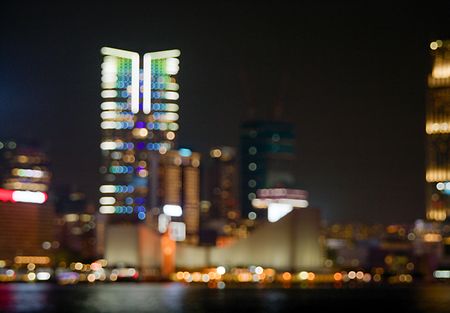The world was watching when, on April 15, 2019, the Notre-Dame cathedral in Paris caught fire. A notable UNESCO World Heritage site, Notre-Dame is considered to be one of the finest examples of Gothic architecture anywhere. Netflix’s recent drama series “Notre-Dame” seeks to retell this dramatic event, based on the accounts of French firefighters. It portrays the impact of the Notre-Dame fire on different people in Paris. ARRI spoke with cinematographer Jean-Max Bernard about his choices and experiences in bringing this emotional event back to life.
The new Netflix event series tackles the terrible fire of Notre-Dame de Paris. How did you approach this complex project?
I have been working with director Hervé Hadmar for fifteen years. I know his way of working very well. He has the particularity of only directing series that he has written, this time with co-writer Olivier Bocquet. We worked together very early on, right from the first versions of the script. This gave us time to think, to advance step by step towards the image choices. On this series, Hervé was very interested in the colors of stained glass. He wanted us to find these tones in the settings and in the light. He also gave me several references to films and series with very strong colors: “Only God Forgives” and “Too Old to Die Young” by Nicolas Winding Refn. We also looked at the series “The Mosquito Coast” which interested us a lot. It was an ongoing dialogue with the director. The goal was to bring an idea of color and tone close to stained glass to the series, without being too ostentatious.
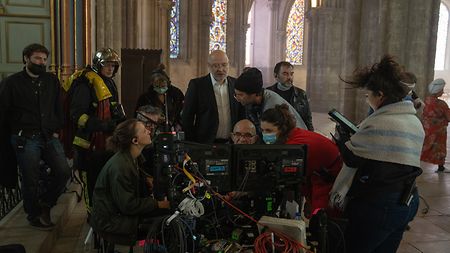
Director Hervé Hadmar (center, white shirt), cinematographer Jean-Max Bernard (center, left of blue mask) and some members of the film crew
Why did you choose ARRI Signature Prime lenses for “Notre-Dame”?
The choice of lenses was very important to me on such a complex series, where I was dealing with fire and juggling different layers of smoke. I knew I would have to filter as little as possible to avoid double images. When we did comparative tests on faces with smoke, the Signature Primes stood out immediately. They were exactly the right lenses for the job. They had the roundness and finesse that would allow us to work virtually filter-free all the time. With these lenses, I used a lot of wide focal lengths at apertures of 2 or 2.8, with the idea of losing depth of field. This gives a real density to the image. The bokehs are also very nice, elegant, round, and fine. In addition, I find that Signature Primes give a very nice velvety look to the faces without being too soft or mushy. It’s an excellent combination having both the sharpness and the velvetiness. I had a great time on the shoot with these lenses. The Signatures Primes are a big achievement from ARRI.
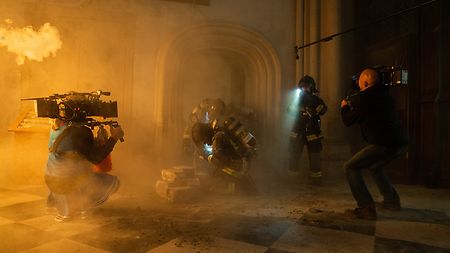
Using ARRI Signature Prime lenses was very important to deal with fire and different layers of smoke in “Notre-Dame”

“When we did comparative tests on faces with smoke, the Signature Primes were an immediate choice,” states DP Bernard
And what about the camera, how did the ALEXA Mini LF perform?
We shot with two ALEXA Mini LFs: one handheld and the other one on Steadicam or crane. I’ve always worked with ALEXA cameras, and I didn’t want to experiment with anything else on such an important project. For this series, the ALEXA Mini LF was the safe choice, something very pragmatic. It is a camera that I know well. Its sensor offers a very wide latitude. It goes very deep into the blacks without going into a spin in the highlights. This was even more important as I was working with an open aperture. The story takes place almost entirely at night since the fire started in the early evening. As a result, the shoot was always a juggling act between the highlights of the flames, the shadows in the sets, and the firemen dressed in black. I needed a camera that could handle great contrasts, hence the choice of the ALEXA Mini LF. I also knew that in the sequences shot in the cathedral of Bourges for example, I was going to have to work in low light by relying on the existing atmosphere. The sensor gave me the latitude to shoot with very few sources. Not to mention the compactness of the Mini LF, which was essential for me to be able to work handheld in the very narrow stairs of real cathedrals.

Scene on the stairs of the Bourges cathedral

A "safe choice" for DP Bernard: The ALEXA Mini LF on Steadicam
At what exposure did you use the camera?
In general, I play very little on exposure. This time I was always at 800 ASA, maybe once or twice at 1600 ASA, but that's it. On “Notre-Dame,” the big job was to play on tones and colors. With my colorist, Gilles Granier, we worked very early on to develop a LUT that would work for the entire film. In this series, the rendering is not very naturalistic, especially of the skins. It wouldn’t have made sense with the firemen covered in soot and exposed to the flames. So I had a lot of freedom to develop a LUT that would significantly change the color rendering and meet the director’s desired direction. With the colorist, we studied the different atmospheres of the series in detail, prepared several LUTs, to finally arrive at the one that we were fully satisfied with. After that, we just had to install it on the ALEXA Mini LF.
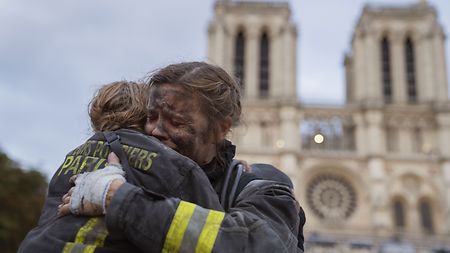
Scene with firewomen in front of the cathedral Notre-Dame de Paris

Many scenes in “Notre-Dame” show firemen covered in soot and exposed to the flames
How did you work with color on set?
On each film or series, I always do some preparatory work beforehand, where I test different gelatins according to each sequence. I go through a Lee sampler by tints that I spread on windows and, progressively, I select the colorimetric ambiances that interest me, set by set. Then, I transfer them to the ARRI SkyPanels by selecting colors which are close to my gelatins. Afterwards, I make a lot of adjustments according to the LUT, which modifies the colors a lot.
How did you use ARRI SkyPanels to build your light?
I used the SkyPanels a lot in the studio scenes at Bry-sur-Marne. That's where we shot the fire sequences for “Notre-Dame.” On the cathedral corridor set, I had a total of 60 SkyPanels controlled by DMX. On the big set in the nave, we used 25 SkyPanels S60-C, eight SkyPanels S120-C and one SkyPanel S360-C. There were many technical constraints to consider with the fire and special effects. The SkyPanels were used to illuminate the green or blue backgrounds but also, on the nave, to create the luminosity that enters Notre-Dame from the side in the late afternoon. They also allowed me to work on different densities of flame effects. In two seconds, I could go from embers to small flames or a big blaze. I could quickly switch from a rather soft atmosphere during the day to something more flamboyant at night, without it having any impact on the set preparation time. It’s a real asset. ARRI SkyPanels have really revolutionized the way we work. They save a lot of time on set and offer an extraordinary range of possibilities in the management of colors and luminosity. And the whole thing can be controlled with one finger from a tablet. The SkyPanels have really expanded our playground.
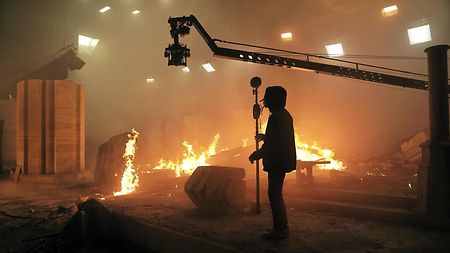
ARRI SkyPanels and the ALEXA Mini LF on a crane in action for the series “Notre-Dame”

A total of 60 ARRI SkyPanels were used for the studio scenes at Bry-sur-Marne
What lights did you use on the exteriors?
The SkyPanels were also very useful on the Notre-Dame square, day and night. We had the exceptional authorization to shoot on the real square to recreate the scenes with the fire trucks. The special effects team had installed a 30 m x 6 m blue background that I lit with SkyPanels. My gaffer Philippe Wegiel installed four gondolas at 20 meters high on both sides of the square, each equipped with two SkyPanels S60-C and one SkyPanel S120-C. For backlighting I had two SkyPanels S120-C and three SkyPanels S60-C. Some were programmed to extend the yellow/green ambiance of the urban lighting, in which I mixed cyan. Others helped me to reinforce the blue/blue, blue/red flashing effect.
How were your experiences with color grading in HDR?
I come from 35 mm film, which I left with a certain nostalgia. But, at the same time, digital filmmaking allows us to create images that we could never have made on film, especially in terms of colorimetry. Concerning HDR, I had worked with the colorist beforehand to get a good feel for the difference in rendering with SDR. HDR may look brighter and sharper, but above all, it has the advantage of going further into the highlights. It was very valuable on this film where we had a lot of fire scenes with dark backgrounds. On my side, I was trying to keep the image uniform so there wouldn’t be any bad surprises. But I knew that HDR would give me much more substance in the high and low lights. On the flames, HDR is clearly more flattering, bringing a great richness of detail. In color grading, anything that gives us more latitude is a good thing. And you can grade HDR gracefully and avoid the glare. If everyone could watch the show in HDR, it would be ideal.
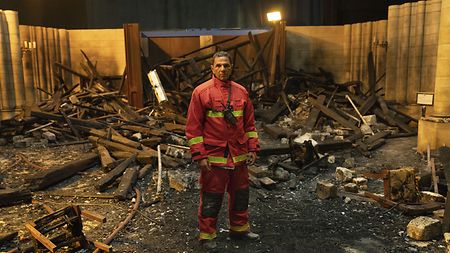
Actor Roschdy Zem on the set of “Notre-Dame”

DP Jean-Max Bernard with the ALEXA Mini LF and Signature Primes and actress Megan Northam
Photo credits: Emmanuel Guimier, Netflix

